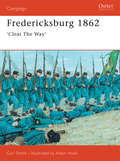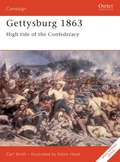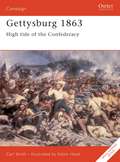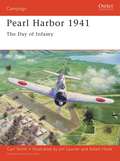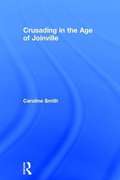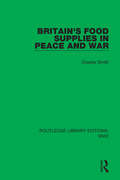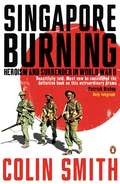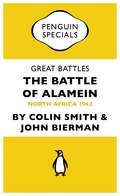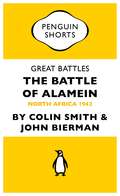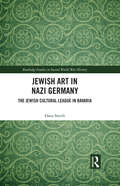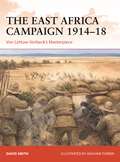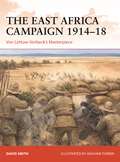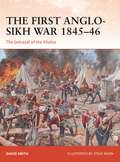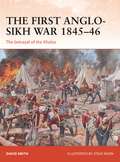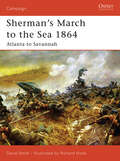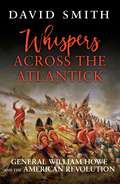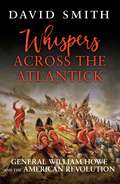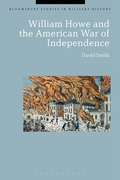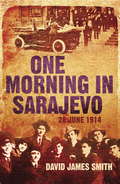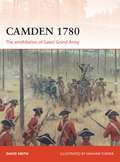- Table View
- List View
Fredericksburg 1862: 'Clear The Way' (Campaign)
by Carl Smith Adam HookIn December 1862, things were still confused for the Union. Antietam had been a failure for both sides, and although the battle showed that the Union army could bring the Confederates to bay, it couldn't pin them in one place long enough to destroy them. In December 1862, General Burnside, newly appointed to command the Army of the Potomac, planned to seize and secure the town of Fredericksburg, and then take the Confederate capital of Richmond. Carl Smith's book details the epic struggle that engulfed the Union side as it crossed the Rappahannock on December 11, encountering stiff opposition from Lee's men.
Gettysburg 1863: High tide of the Confederacy (Campaign #52)
by Carl Smith Adam HookThe Confederate invasion of the Northern states was General Lee's last great gamble. By taking the war to the Union he hoped to force Lincoln into peace negotiations, or win support from the European powers who were watching events closely from across the Atlantic. Equally, Meade's Army of the Potomac needed to regain it's fighting credibility after the setbacks of Fredericksburg and saw this as an opportunity to redeem its honour. The clash of 150,000 soldiers from both sides would ultimately decide the fate of a nation.
Gettysburg 1863: High tide of the Confederacy (Campaign #52)
by Carl Smith Adam HookThe Confederate invasion of the Northern states was General Lee's last great gamble. By taking the war to the Union he hoped to force Lincoln into peace negotiations, or win support from the European powers who were watching events closely from across the Atlantic. Equally, Meade's Army of the Potomac needed to regain it's fighting credibility after the setbacks of Fredericksburg and saw this as an opportunity to redeem its honour. The clash of 150,000 soldiers from both sides would ultimately decide the fate of a nation.
Pearl Harbor 1941: The day of infamy (Campaign)
by Carl Smith Jim LaurierDecember 7, 1941 was one of the single most decisive days of World War II the day that brought the USA into the fight. Six Japanese aircraft carriers disgorged their full complements in two waves on the superior US Pacific Fleet as it lay slumbering in Pearl Harbor. Depending on opposing viewpoints, the attack was either a brilliant maneuver of audacious strategy, or a piece of unparalleled villainy and deception by a supposedly friendly power. This revised edition, containing the latest research on the events of December 7, 1941, reveals several previously unknown aspects of the attack and dispels key myths that have been built up around the fateful day a day, Franklin Delano Roosevelt declared, that would "live in infamy".
Crusading In The Age Of Joinville
by Caroline SmithCrusading in the Age of Joinville enhances the current literature dealing with the issue of crusaders' motivations by providing a detailed examination of the ideas and experiences of those who promoted and participated in the crusades of Louis IX of France in the mid-thirteenth century. It assesses the possibilities and problems associated with the source material available to historians of crusading in the thirteenth century and highlights the unique nature and value of John of Joinville's Life of Saint Louis. Two distinct approaches are taken to the analysis of these sources in order to demonstrate their richness. The first of these is thematic and is employed to reveal contrasts between the idealised images of crusading depicted by its promoters and the experiences of those who responded to their calls to take the cross. Secondly, the careers of Joinville and his close contemporary Oliver of Termes provide extended case studies demonstrating that involvement with crusading could have very different origins and expressions. Overall, Crusading in the Age of Joinville provides an innovative and accessible study of crusaders and crusading in the thirteenth century.
Crusading In The Age Of Joinville (PDF)
by Caroline SmithCrusading in the Age of Joinville enhances the current literature dealing with the issue of crusaders' motivations by providing a detailed examination of the ideas and experiences of those who promoted and participated in the crusades of Louis IX of France in the mid-thirteenth century. It assesses the possibilities and problems associated with the source material available to historians of crusading in the thirteenth century and highlights the unique nature and value of John of Joinville's Life of Saint Louis. Two distinct approaches are taken to the analysis of these sources in order to demonstrate their richness. The first of these is thematic and is employed to reveal contrasts between the idealised images of crusading depicted by its promoters and the experiences of those who responded to their calls to take the cross. Secondly, the careers of Joinville and his close contemporary Oliver of Termes provide extended case studies demonstrating that involvement with crusading could have very different origins and expressions. Overall, Crusading in the Age of Joinville provides an innovative and accessible study of crusaders and crusading in the thirteenth century.
Britain's Food Supplies in Peace and War (Routledge Library Editions: WW2 #3)
by Charles SmithThis book, first published in 1940, is a systematic analysis of Britain’s principal food supplies and the means by which they are distributed to the people. Its calculates the total quantities of food required to feed the whole nation properly, examines pricing structures and the sources of the food stuffs. Both home produced and imported foods are covered in this survey, as are restrictions in the form of the wartime governmental controls.
Britain's Food Supplies in Peace and War (Routledge Library Editions: WW2 #3)
by Charles SmithThis book, first published in 1940, is a systematic analysis of Britain’s principal food supplies and the means by which they are distributed to the people. Its calculates the total quantities of food required to feed the whole nation properly, examines pricing structures and the sources of the food stuffs. Both home produced and imported foods are covered in this survey, as are restrictions in the form of the wartime governmental controls.
Singapore Burning: Heroism and Surrender in World War II
by Colin SmithChurchill's description of the fall of Singapore on 15 February 1942, after Lt-Gen Percival's surrender led to over 100,000 British, Australian and Indian troops falling into the hands of the Japanese, was no wartime exaggeration. The Japanese had promised that there would be no Dunkirk in Singapore, and its fall led to imprisonment, torture and death for thousands of allied men and women. With much new material from British, Australian, Indian and Japanese sources, Colin Smith has woven together the full and terrifying story of the fall of Singapore and its aftermath. Here, alongside cowardice and incompetence, are forgotten acts of enormous heroism; treachery yet heart-rending loyalty; Japanese compassion as well as brutality from the bravest and most capricious enemy the British ever had to face.
Alamein: War Without Hate
by Colin Smith John Bierman'Excellent ... a remarkable achievement and ought to be recognised as one of the most successful histories of the Western Desert and North African fighting yet to have appeared' John Keegan, Daily TelegraphFor the British, the battle fought at El Alamein in October 1942 became the turning point of the Second World War. In this study of the desert war, John Bierman and Colin Smith show why it is remembered by its survivors as a 'war without hate'. Through extensive research the authors provide a compellingly fresh perspective on the see-saw campaign in which the two sides chased each other back and forth across the unforgiving North African landscape.
Great Battles: North Africa 1942 (Penguin Specials)
by Colin Smith John BiermanPenguin Specials are designed to fill a gap. Written to be read over a long commute or a short journey, they are original and exclusively in digital form. In this Special, Colin Smith and John Bierman make the battle of Alamein come alive.A turning point in the Second World War, the battle of El Alamein was the culmination of a military campaign like no other. Fought across desolate arid terrain, the brutal fighting was matched by a camaraderie and respect between enemies as witnessed in no other theatre of war. Combining gritty personal testimonies with thorough journalistic investigation, John Bierman and Colin Smith present a compelling account of a ferocious but compassionate battle and a journey through the unforgiving North African landscape.
Jewish Art in Nazi Germany: The Jewish Cultural League in Bavaria (Routledge Studies in Second World War History)
by Dana SmithThis book provides a social and cultural history of Jewish art in Nazi Germany, with a focus on the Jewish artists, art critics, and audiences in Nazi Bavaria. From the time of its conceptualization in the autumn of 1933 until its final curtain call in November 1938, the Jewish Cultural League in Bavaria sustained three departments: music, visual arts, and adult education. The Bavarian example steps outside the highly professional cultural milieu of Jewish Berlin, and instead looks at relatively unknown efforts of Bavarian Jewish artists as they used art to define what it now meant, to them, to be Jewish under Nazism. Insightful and engaging, this book is ideal for advanced undergraduate students, graduate students, and scholars interested in social and cultural histories of Jews in Germany.
Jewish Art in Nazi Germany: The Jewish Cultural League in Bavaria (Routledge Studies in Second World War History)
by Dana SmithThis book provides a social and cultural history of Jewish art in Nazi Germany, with a focus on the Jewish artists, art critics, and audiences in Nazi Bavaria. From the time of its conceptualization in the autumn of 1933 until its final curtain call in November 1938, the Jewish Cultural League in Bavaria sustained three departments: music, visual arts, and adult education. The Bavarian example steps outside the highly professional cultural milieu of Jewish Berlin, and instead looks at relatively unknown efforts of Bavarian Jewish artists as they used art to define what it now meant, to them, to be Jewish under Nazism. Insightful and engaging, this book is ideal for advanced undergraduate students, graduate students, and scholars interested in social and cultural histories of Jews in Germany.
The East Africa Campaign 1914–18: Von Lettow-Vorbeck’s Masterpiece (Campaign)
by David SmithA fascinating, beautifully illustrated study of the daring war in East Africa waged by German colonial forces under Paul von Lettow-Vorbeck against the wide array of colonial and expeditionary forces of the Allied Powers.The East African Campaign in World War I comprised a series of battles and guerrilla actions which began in German East Africa in 1914 and spread to portions of Portuguese Mozambique, northern Rhodesia, British East Africa, the Uganda Protectorate, and the Belgian Congo. German colonial forces under Lieutenant-Colonel Paul von Lettow-Vorbeck attempt to divert Allied forces from the Western Front. Despite the efforts of the Allied forces, Lettow-Vorbeck's troops remained undefeated at the end of the war.In this fascinating work, David Smith documents how a wide array of British, Indian, South African, Belgian, Portuguese and local native forces invaded German East Africa and slowly ousted the German forces, a process made tortuous by Lettow-Vorbeck's masterful management of the campaign. Among the events covered in this work are the Battle of Tanga, the scuttling of the Königsberg, the German railway campaign, and the battles at Salaita Hill, Kondoa-Irangi, Mahenge, Mahiwa and Namacurra. Colourful period and specially commissioned illustrations bring to life a wide-ranging and eventful campaign in which a high price was extracted for every inch of ground given up.
The East Africa Campaign 1914–18: Von Lettow-Vorbeck’s Masterpiece (Campaign)
by David SmithA fascinating, beautifully illustrated study of the daring war in East Africa waged by German colonial forces under Paul von Lettow-Vorbeck against the wide array of colonial and expeditionary forces of the Allied Powers.The East African Campaign in World War I comprised a series of battles and guerrilla actions which began in German East Africa in 1914 and spread to portions of Portuguese Mozambique, northern Rhodesia, British East Africa, the Uganda Protectorate, and the Belgian Congo. German colonial forces under Lieutenant-Colonel Paul von Lettow-Vorbeck attempt to divert Allied forces from the Western Front. Despite the efforts of the Allied forces, Lettow-Vorbeck's troops remained undefeated at the end of the war.In this fascinating work, David Smith documents how a wide array of British, Indian, South African, Belgian, Portuguese and local native forces invaded German East Africa and slowly ousted the German forces, a process made tortuous by Lettow-Vorbeck's masterful management of the campaign. Among the events covered in this work are the Battle of Tanga, the scuttling of the Königsberg, the German railway campaign, and the battles at Salaita Hill, Kondoa-Irangi, Mahenge, Mahiwa and Namacurra. Colourful period and specially commissioned illustrations bring to life a wide-ranging and eventful campaign in which a high price was extracted for every inch of ground given up.
The First Anglo-Sikh War 1845–46: The betrayal of the Khalsa (Campaign)
by David SmithThe First Anglo-Sikh War broke out due to escalating tensions between the Sikh Empire and the British East India Company in the Punjab region of India in the mid-nineteenth century. Political machinations were at the heart of the conflict, with Sikh rulers fearing the growing power of their own army, while several prominent Sikh generals actively collaborated with the East India Company.The British faced a disciplined opponent, trained along European lines, which fielded armies numbering in the tens of thousands. The war featured a number of closely contested battles, with both sides taking heavy losses. This fully illustrated study of the First Anglo-Sikh War tells the story of one of the major colonial wars of the nineteenth century, as the East India Company attempted to wrest control of the Punjab region from a Sikh Empire riven by infighting.
The First Anglo-Sikh War 1845–46: The betrayal of the Khalsa (Campaign)
by David SmithThe First Anglo-Sikh War broke out due to escalating tensions between the Sikh Empire and the British East India Company in the Punjab region of India in the mid-nineteenth century. Political machinations were at the heart of the conflict, with Sikh rulers fearing the growing power of their own army, while several prominent Sikh generals actively collaborated with the East India Company.The British faced a disciplined opponent, trained along European lines, which fielded armies numbering in the tens of thousands. The war featured a number of closely contested battles, with both sides taking heavy losses. This fully illustrated study of the First Anglo-Sikh War tells the story of one of the major colonial wars of the nineteenth century, as the East India Company attempted to wrest control of the Punjab region from a Sikh Empire riven by infighting.
Sherman's March to the Sea 1864: Atlanta to Savannah (Campaign #179)
by David SmithRiding on the wave of his victory at Atlanta, Union General W. T. Sherman abandoned his supply lines in an attempt to push his forces into Confederate territory and take Savannah. During their 285-mile 'March to the Sea' the army lived off the land and destroyed all war-making capabilities of the enemy en route. Despite the controversy surrounding it, the march was a success. Supported by photographs, detailed maps, and artwork, this title explores the key personalities and engagements of the march and provides a detailed analysis of the campaign that marked the 'beginning of the end' of the Civil War.
Whispers Across the Atlantick: General William Howe and the American Revolution
by David SmithGeneral William Howe was the commander-in-chief of the British forces during the early campaigns of the American Revolutionary War (1775-1783). Howe evoked passionate reactions in the people he worked with – his men loved him, his second-in-command detested him, his enemies feared him, his political masters despaired of him. There was even a plot to murder him, in which British officers as well as Americans were implicated. Howe's story includes intrigue, romance and betrayal, played out on the battlefields of North America and concluding in a courtroom at the House of Commons, where Howe defended his decisions with his reputation and possibly his life on the line. The inquiry, complete with witness testimonies and savage debate between the bitterly divided factions of the British Parliament, gives Howe's story the flavour of a courtroom drama. Using extensive research and recent archival discoveries, this book tells the thrilling story of the man who always seemed to be on the verge of winning the American Revolutionary War for Britain, only to repeatedly fail to deliver the final blow.
Whispers Across the Atlantick: General William Howe and the American Revolution
by David SmithGeneral William Howe was the commander-in-chief of the British forces during the early campaigns of the American Revolutionary War (1775-1783). Howe evoked passionate reactions in the people he worked with – his men loved him, his second-in-command detested him, his enemies feared him, his political masters despaired of him. There was even a plot to murder him, in which British officers as well as Americans were implicated. Howe's story includes intrigue, romance and betrayal, played out on the battlefields of North America and concluding in a courtroom at the House of Commons, where Howe defended his decisions with his reputation and possibly his life on the line. The inquiry, complete with witness testimonies and savage debate between the bitterly divided factions of the British Parliament, gives Howe's story the flavour of a courtroom drama. Using extensive research and recent archival discoveries, this book tells the thrilling story of the man who always seemed to be on the verge of winning the American Revolutionary War for Britain, only to repeatedly fail to deliver the final blow.
William Howe and the American War of Independence (Bloomsbury Studies in Military History)
by David SmithThe first major work on this enigmatic British general for more than 40 years, William Howe and the American War of Independence offers fascinating new insights into his performance during the revolution in America. From 1775 to 1777, Howe commanded the largest expeditionary force Britain had ever amassed, confronting the rebel army under George Washington and enjoying a string of victories. However, his period in command ended in confusion, bitterness and a parliamentary inquiry, because he proved unable to crush the rebellion. Exactly what went wrong has puzzled historians for more than 200 years. For most Howe has been relegated to the role of a bit player, but, with the help of new evidence, this book looks afresh at his army, his relationships with key military and political figures and his own personal qualities. The result is a compelling reassessment of a forgotten general that offers a new perspective on a man who won his battles, but could not win his war.
William Howe and the American War of Independence (Bloomsbury Studies in Military History)
by David SmithThe first major work on this enigmatic British general for more than 40 years, William Howe and the American War of Independence offers fascinating new insights into his performance during the revolution in America. From 1775 to 1777, Howe commanded the largest expeditionary force Britain had ever amassed, confronting the rebel army under George Washington and enjoying a string of victories. However, his period in command ended in confusion, bitterness and a parliamentary inquiry, because he proved unable to crush the rebellion. Exactly what went wrong has puzzled historians for more than 200 years. For most Howe has been relegated to the role of a bit player, but, with the help of new evidence, this book looks afresh at his army, his relationships with key military and political figures and his own personal qualities. The result is a compelling reassessment of a forgotten general that offers a new perspective on a man who won his battles, but could not win his war.
One Morning In Sarajevo: 28 June 1914
by David James SmithSarajevo, 28 June 1914: The story of the assassination that changed the world.A historical account of the assassination of Archduke Franz Ferdinand. Using newly available sources and older material, David James Smith brilliantly reinvestigates and reconstructs the events which subsequently determined the shape of the twentieth century.Young Gavrilo Princip arrived at the Vlajnic pastry shop in Sarajevo in Bosnia-Herzegovina on the morning of 28 June 1914. He was greeted by his fellow conspirators in the plot to kill Archduke Franz Ferdinand. The Archduke, next in line to succeed as Emperor of Austria, was beginning a state visit to Sarajevo later that morning. Ferdinand was not a very popular character - widely thought of as bad-tempered and arrogant and perhaps even deranged. To the young students he embodied everything they loathed about imperial oppression. They planned to kill him at about 11 o'clock as he paraded down Appel Quay to the town hall in his open top car.What happened in those few hours - leading as it did to the First and Second World Wars - is as compelling as any thriller.
Camden 1780: The annihilation of Gates’ Grand Army (Campaign #292)
by David Smith Graham TurnerAs the American Revolution continued, the British refocused their fight on the southern colonies in the hopes of triggering an outbreak of loyalism that would sweep the rebels aside. Under Sir Henry Clinton they captured Savannah at the end of 1778, and Charleston in May 1780, with Lord Cornwallis being left in command with just 8,500 men under him. Too thinly spread to guard the 15,000 square miles he was responsible for, Cornwallis went on the offensive, invading North Carolina and using Camden as a launch pad. This new history reveals how Cornwallis was able to use his aggressive strategy to great effect and how the overconfidence of the re-formed American forces under Horatio Gates was to result in a shocking defeat on the night of 15 August 1780 – a defeat that would allow Cornwallis to push deep into North Carolina the following year, where he would only be stopped by the American victory at Yorktown.
The Electric Hotel: A Novel
by Dominic SmithFrom the award-winning author of the acclaimed bestseller The Last Painting of Sara de Vos comes a radiant new novel tracing the intertwined fates of a silent film director and his muse.The Electric Hotel winds through the nascent days of cinema in Paris and Fort Lee, New Jersey - America's first movie town - and the battlefields of Belgium during World War I. A sweeping work of historical fiction, it shimmers between past and present as it tells the story of the rise and fall of a prodigious film studio and one man's doomed obsession with all that passes in front of the viewfinder.For nearly half a century, Claude Ballard has been living at the Hollywood Knickerbocker Hotel. A French pioneer of silent films, who started out as a concession agent for the Lumière brothers, the inventors of cinema, Claude now spends his days taking photographs of Sunset Boulevard. But when a film-history student comes to interview Claude about The Electric Hotel - the lost masterpiece that bankrupted him and ended the career of his muse, Sabine Montrose - the past comes surging back. In his run-down hotel suite, the ravages of the past are waiting to be excavated: celluloid fragments and reels in desperate need of restoration, and Claude's memories of the woman who inspired and beguiled him.The Electric Hotel is a portrait of a man entranced by the magic of movie-making, a luminous romance and a whirlwind trip through the heady, endlessly inventive days of early cinema.
